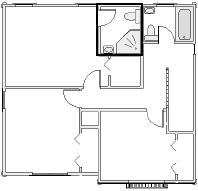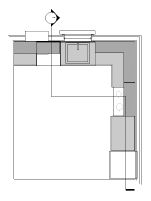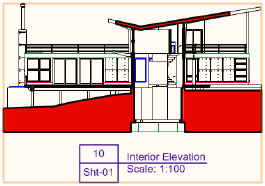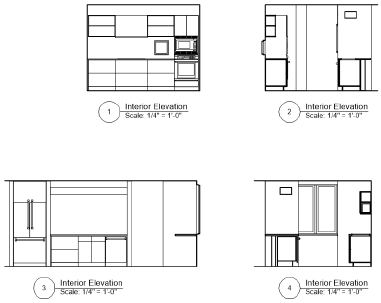
Presenting the Project
Viewports can display entire, as well as cropped, views of a drawing, with specified layer and class visibility settings, projection, render mode, and orientation parameters (complete with details, annotations, dimensions, and title blocks). Viewports can show other parts of the active document, or even portions of other documents. If the drawing changes, update the viewports to reflect the changes.

There are several different types of viewports, depending on whether you have the Vectorworks Fundamentals product or one or more Vectorworks Design Series products.
Sheet layer viewports
In both the Vectorworks Fundamentals and Vectorworks Design Series products, you can create one or more viewports on a sheet layer, and each viewport can show one or more design layers from this document. Sheet layer viewports, often created for presentation purposes, are created on special layers called sheet layers. Sheet layers retain their own print settings, including print area, resolution, and printer setup parameters. For more information on sheet layers, see Creating Layers. A sheet layer viewport can also be linked to a Renderworks camera.
Design layer viewports (Vectorworks Design Series required)
Vectorworks Design Series products allow you to create one or more viewports on a design layer, and the design layers shown in the viewports can be either from the current document, or referenced from another document. Like a sheet layer viewport, a design layer viewport can display design layers from the current file in a full or cropped view; unlike a sheet layer viewport, it can include one or more design layers that are referenced from another file.
Section viewports (Vectorworks Design Series required)
A section viewport creates a cross section view of a model, but leaves the model intact. A section viewport can be created from a design layer, another non-sectioned viewport, or a clip cube on a design layer; it can be placed on a design layer or sheet layer.
Interior elevation viewports (Vectorworks Architect required)
Interior elevation viewports are section viewports that allow you to simultaneously create as many as four interior elevation viewports from a selected room or area of the model. An interior-elevation marker automatically placed on the design layer allows you to edit which views you display and maintains coordination between the drawing and the viewports. These viewports can be placed on either a design layer or a sheet layer.
Detail viewports (Vectorworks Design Series required)
A detail viewport is a cropped sheet layer viewport that shows a detail view of any part of a drawing. A detail viewport can be created from a design layer, another sheet layer viewport, or a section viewport. The crop object used to create the detail viewport becomes a callout object that is linked to the detail viewport for easy navigation between layers.
The Viewports tab of the Organization dialog box differentiates among the various types of viewports.

Click here for a video tip about this topic (internet access required).
~~~~~~~~~~~~~~~~~~~~~~~~~
To create a viewport from a design layer:
1 Select View > Create Viewport.
2 The Create Viewport dialog box opens. The viewport parameters are initially set to be the same as those of the design layer that is currently active, but they can be changed here. After the viewport has been created, additional parameters become available; see “Viewport Properties” on page 1641.
For Vectorworks Design Series products, the Create Viewport dialog box has additional functionality for creating design layer viewports; see “Creating a Design Layer Viewport from an Internal Design Layer” on page 1617.
Click to show/hide the parameters.
3 Enter the desired parameters and click OK.
4 If a sheet layer does not already exist in the file, the New Sheet Layer dialog box opens automatically to create one. Click OK.
The viewport is created on the designated sheet layer, and the sheet layer becomes active.
~~~~~~~~~~~~~~~~~~~~~~~~~
To create a cropped viewport either from a design layer or from an existing uncropped viewport on a sheet layer:
1 Activate the existing design layer or sheet layer that will display in the viewport.
2 Create a 2D object such as a rectangle, circle, or polyline. The 2D object must define an area; for example, a 2D line cannot be used. Crop objects are automatically placed in the screen plane (see Planar Modes of 2D Objects: Screen Plane and Layer Plane). Position the 2D object on the design layer or existing uncropped viewport to delimit the area to be included in the new viewport. The fill of a viewport cropping object is always None; however, the pen style can be set from the Attributes palette.

3 If the cropped viewport is being created from a design layer, select the 2D object. If the cropped viewport is being created from a sheet layer, select both the 2D object and the uncropped viewport.
4 Select View > Create Viewport.
5 An alert dialog box asks whether the object should be used as the viewport’s crop. Click Yes (click Always do the selected action to always use a selected 2D object as a crop object when creating viewports).
6 The Create Viewport dialog box opens. Enter a viewport name and drawing title, and select the sheet layer to place it on. The remaining viewport parameters are initially set to be the same as the design layer properties (for design layers) or selected viewport (for sheet layers). Change the parameters as needed.
7 Click OK.
The viewport, cropped by the selected 2D object, is created on the specified sheet layer.
8 By default, the crop object is not visible. To change the visibility of the crop object, select the viewport and click Crop Visible from the Object Info palette.

~~~~~~~~~~~~~~~~~~~~~~~~~
 Creating Multiple
Viewports Simultaneously
Creating Multiple
Viewports SimultaneouslyThe Create Multiple Viewports command generates 2D drawings from a 3D model and creates up to seven sheet layer viewports configured with several orthographic views and one isometric view of the model.
If you run the command from a sheet layer, the viewports are added to that sheet layer. If you run the command from a design layer, the viewports are added to a new sheet layer that is created automatically.
To create as many as four interior elevation viewports of the same space simultaneously, see “Creating Interior Elevation Viewports” on page 1632.
To create multiple viewports simultaneously:
1 Select View > Create Multiple Viewports.
The Create Multiple Viewports dialog box opens.
2 Specify the desired viewport scale, views, and angle projection method, and then click OK.
Click to show/hide the parameters.
Viewports are created at the designated layer scale, using the current layer and class visibility and print area settings, with the rendered style set to hidden line rendering. Viewports are aligned horizontally and vertically, separated by a fixed distance, and centered on the sheet layer.
3 Optionally, configure the viewports’ layer and class settings (Active, Show, or Gray Others only), annotate the viewport, or modify the rendering style or other viewport parameters.
For more information, see Setting Class and Design Layer Visibility for Viewports and Saved Views, Creating Annotations for Sheet Layer Viewports, and “Viewport Properties” on page 1641.
~~~~~~~~~~~~~~~~~~~~~~~~~
 Creating Design
Layer Viewports
Creating Design
Layer ViewportsA sheet layer viewport displays a full or cropped view of one or more design layers, which you can change without affecting the original drawing. For example, change the viewport’s layer and class visibilities, use a different render mode, or add annotations and dimensions. (See “Creating Sheet Layer Viewports” on page 1612.)
Design layer viewports provide different functionality, for more flexibility. Like a sheet layer viewport, a design layer viewport can display design layers from the current file in a full or cropped view; unlike a sheet layer viewport, it can include one or more design layers that are referenced from another file.
Like a sheet layer viewport, in a design layer viewport you can control layer and class visibility, and create layer and class overrides. However, because it is an object on a design layer, a design layer viewport has the same view, scale, and render mode as everything else on the layer. You can use 2D and 3D drawing tools to add objects to the design layer, but you cannot add annotations to a design layer viewport.
Design layer viewports replace the layer link functionality present in the Vectorworks Fundamentals product. Current layer links can be easily converted to a design layer viewport with the Modify > Convert > Convert to Viewport command (Vectorworks Design Series required). (See Converting Layer Links.)
The search criteria used in worksheets and in the Script Editor allow you to filter out items from design layer viewports, to prevent unwanted duplicates in schedules.
~~~~~~~~~~~~~~~~~~~~~~~~~
 Creating a Design Layer Viewport
from an Internal Design Layer
Creating a Design Layer Viewport
from an Internal Design LayerTo create a design layer viewport that displays a design layer in the same file:
1 Select View > Create Viewport. Alternatively, from either the Organization dialog box or the Navigation palette, select the Viewports tab, and click New.
2 The Create Viewport dialog box opens. The scale, view, and render mode of the viewport are determined by the design layer on which it is placed; they cannot be changed here. Set the other viewport parameters. After the viewport has been created, additional parameters become available; see Editing a Design Layer Displayed in a Viewport.
Click to show/hide the parameters.
3 Click OK.
The viewport is created on the designated design layer, and the design layer becomes active. The viewport can be cropped, as described in Cropping Existing Sheet Layer or Design Layer Viewports.
~~~~~~~~~~~~~~~~~~~~~~~~~
 Creating a Design Layer Viewport
by Cropping
Creating a Design Layer Viewport
by CroppingThe viewport and the design layer that it displays must both be in the same file.
To create a design layer viewport by cropping:
1 Access the design layer that will display in the viewport.
2 Create a 2D object such as a rectangle, circle, or polyline. The 2D object must define an area; for example, a 2D line cannot be used. Crop objects are automatically placed in the screen plane (see Planar Modes of 2D Objects: Screen Plane and Layer Plane). Position the 2D object on the design layer to delimit the area to be included in the new viewport. The fill of a viewport crop object is always None; however, the pen style can be set from the Attributes palette.
3 Select the 2D crop object, and then select View > Create Viewport.
4 An alert dialog box asks whether the object should be used as the viewport’s crop. Click Yes (also select Always do the selected action to always use a selected 2D object as a crop object when creating viewports).
5 The Create Viewport dialog box opens. Select the design layer on which to create the viewport. The Source must be the current document. Specify the design layers and classes to display in the viewport. (See Changing the Layer Properties of Sheet Layer or Design Layer Viewports and Changing the Class Properties of Sheet Layer or Design Layer Viewports.)
6 Click OK.
The viewport, cropped by the selected 2D object, is created on the specified design layer.
7 By default, the crop object is not visible. To change the visibility of the crop object, select the viewport and select the Crop Visible setting from the Object Info palette.

~~~~~~~~~~~~~~~~~~~~~~~~~
 Creating a Referenced Design Layer
Viewport
Creating a Referenced Design Layer
ViewportReferencing allows you to use information from other Vectorworks files in your file, including design layers, classes, and resources (such as hatches, worksheets, or symbols). There are two ways to reference design layers that are in other Vectorworks files:
• The default method in the Vectorworks Design Series products is to create a design layer viewport and then reference the desired design layers from the master file into the viewport, as described here. One advantage to this method is that all of the layers, classes, and resources from the master file are not automatically imported into the target file.
• In the Vectorworks Fundamentals product, design layers are imported into the target file when they are referenced. For backward compatibility, the Vectorworks Design Series products support this method. See Adding and Editing Layer Import References.
A reference for a design layer viewport can be created when the viewport is created, or it can be created ahead of time from the References tab of the Organization dialog box.
To create a design layer viewport that references a design layer in another file:
1 If the current file uses layer import referencing, switch to design layer viewport referencing. (From the References tab of the Organization dialog box, click Settings, and click the Design layer viewports option from the Reference Settings dialog box. Any existing referenced layers are automatically converted into referenced design layer viewports.)
2 Select View > Create Viewport. Alternatively, from either the Organization dialog box or the Navigation palette, select the Viewports tab, and click New.
3 The Create Viewport dialog box opens. Enter a Viewport Name and Drawing Title, and then select the design layer on which to create the viewport.
4 Click Select Source to open the Select Viewport Source dialog box, and enter information about the referenced document.
Click to show/hide the parameters.
5 Click OK in the Select Viewport Source dialog box to return to the Create Viewport dialog box.
6 Specify the design layers and classes to display in the viewport (see Changing the Layer Properties of Sheet Layer or Design Layer Viewports and Changing the Class Properties of Sheet Layer or Design Layer Viewports).
7 Click OK.
The viewport is created on the designated design layer, and the design layer becomes active. The viewport can be cropped, as described in Cropping Existing Sheet Layer or Design Layer Viewports.
The master file displays on the References tab of the Organization dialog box; for details about how to edit, update, or delete references, see Workgroups and Referencing.
~~~~~~~~~~~~~~~~~~~~~~~~~
 Creating Section Viewports
Creating Section ViewportsA section viewport creates a cross section view of a model, but leaves the model intact. The section viewport can display a 2D cross section view of only the objects that intersect the section line, or, additionally, the 3D geometry that remains on the indicated side of an infinite plane passing through the section line. Typically, a section view is either vertical or horizontal to the design layer plane. Horizontal sections are essential for BIM projects, to create plan drawings from 3D models.
Create a live section view from one or more design layers, from a clip cube on a design layer, or from a viewport on a sheet layer. By creating several section viewports, models can be analyzed and presented effectively. The section views can be updated as the model changes, and their attributes and appearance can be easily changed.
A section viewport can be created on either a sheet layer or a design layer; the functionality and purpose of the two types of section viewports are different.
Section viewports on sheet layers can include annotations and automatic drawing coordination of the sheet and drawing numbers; also, if there are multiple viewports on a sheet layer, each can a have different view and scale. These types of sections are always in Top/Plan view since they are on sheet layers, and are created for construction drawings. To get a 3D “look,” switch to Perspective Projection.
Section viewports on design layers are useful when, for example, a detail section is needed in a Front rendered view. A design layer section viewport allows comparison between a section and an elevation view. In a team environment, the design layer section viewport can be referenced in other files.
In addition to the section line instance that is automatically created, a section-elevation marker can be linked to the section viewport; see “Section Lines and Section-Elevation Markers” on page 1627.
Interior elevation viewports are a subcategory of section viewports that display as many as four elevations of a space as seen from within the room, without creating a cross section of the model; see “Creating Interior Elevation Viewports” on page 1632.
For sheet layer section viewports, to automatically coordinate the sheet numbers and drawing numbers among the sheet borders, drawing labels, and section markers in a file, select Use Automatic Drawing Coordination in the Display tab of the Document Preferences. This feature keeps references up to date, even when drawings are edited or moved to a different layer.
~~~~~~~~~~~~~~~~~~~~~~~~~
 Creating a Section Viewport
on a Sheet Layer
Creating a Section Viewport
on a Sheet LayerWhen you create a section viewport, you can place it on either a sheet layer or design layer. Section viewports on sheet layers can have annotations and automatic drawing coordination of the sheet and drawing numbers; also, if there are multiple viewports on a sheet layer, each can a have different view and scale.
If you need to draw a detailed section, or to reference the section viewport into other files, create the viewport on a design layer instead. (See “Creating a Section Viewport on a Design Layer” on page 1625.)
Create a section view from a design layer, from a clip cube, or from a viewport on a sheet layer. A section viewport that is created from a design layer or clip cube can be updated when changes are made to the design layer. However, a section viewport that is created from a viewport does not maintain a connection to the viewport that created it. It updates when the design layers that are visible in the source viewport change.
To create a section viewport on a sheet layer:
1 Prepare to create the viewport as follows:
• To create a section view from an active design layer, set the layer to Top/Plan view by selecting View > Standard Views > Top/Plan.
• To create a section view from an existing viewport, select a non-sectioned viewport object. The viewport object must be in Top, Bottom, Left, Right, Front, or Back view orientation.
• To create a section view from an existing clip cube object, use the Selection tool to highlight the face of the clip cube where the section will begin. (See Viewing a Model with the Clip Cube.) Right-click (Windows) or Ctrl-click (Mac) to open the context menu.
2 Select View > Create Section Viewport (for a design layer or viewport), or select Create Section Viewport from the context menu (for a clip cube).
3 Draw the section line to create the cutting plane on the design layer or viewport. For a clip cube, skip to step 4; the section line is created automatically from a vertical clip cube face, and no section line is created from a horizontal face.
Click in the drawing and drag the mouse to begin drawing the marker line. Click to mark the end of the line, and then click to indicate the side of the line to look toward (keep), which is indicated by a black arrow. Double-click to end the line.

To create a broken section line, click in the drawing and draw the first segment. Indicate which side of the drawing to show in the viewport. Click and drag to draw additional segments; broken section line segments are always parallel or perpendicular to each other. Double-click to end the broken line.

4 The Create Section Viewport dialog box opens, set to the parameters of the active design layer or non-section viewport.
Click to show/hide the parameters.
5 Click OK. A section line object is created in the design layer (unless you used a horizontal face of a clip cube), or is added to the annotations of the existing non-sectioned viewport. A section viewport is created on the selected sheet layer, and the drawing switches to that sheet layer, displaying the new section viewport.

By default, the cross section areas (along the plane where the section was cut) are displayed in red. To change the fill color, or to display sectioned objects with their original attributes, change the viewport’s Advanced Properties (see “Advanced Section Viewport Properties” on page 1648).
~~~~~~~~~~~~~~~~~~~~~~~~~
 Creating a Section Viewport
on a Design Layer
Creating a Section Viewport
on a Design LayerWhen you create a section viewport, you can place it on either a sheet layer or design layer. Section viewports on design layers are useful when a detailed section is needed, or when the section viewport needs to be referenced into other files.
If you want to use annotations and automatic drawing coordination of the sheet and drawing numbers, or if you need multiple viewports on a sheet layer with different views and scales, create the viewport on a sheet layer instead. (See “Creating a Section Viewport on a Sheet Layer” on page 1621.)
Create a section view from a design layer, from a clip cube, or from a viewport on a sheet layer. A section viewport that is created from a design layer or clip cube can be updated when changes are made to the design layer. However, a section viewport that is created from a viewport does not maintain a connection to the viewport that created it. It updates when the design layers that are visible in the source viewport change.
To create a section viewport on a design layer:
1 Prepare to create the viewport as follows:
• To create a section view from an active design layer, set the layer to Top/Plan view by selecting View > Standard Views > Top/Plan.
• To create a section view from an existing viewport, select a non-sectioned viewport object. The viewport object must be in Top, Bottom, Left, Right, Front, or Back view orientation.
• To create a section view from an existing clip cube object, use the Selection tool to highlight the face of the clip cube where the section will begin. (See Viewing a Model with the Clip Cube.) Right-click (Windows) or Ctrl-click (Mac) to open the context menu.
2 Select View > Create Section Viewport (for a design layer or viewport), or select Create Section Viewport from the context menu (for a clip cube).
3 Draw the section line to create the cutting plane on the design layer or viewport. For a clip cube, skip to step 4; the section line is created automatically from a vertical clip cube face, and no section line is created from a horizontal face.
Click in the drawing and drag the mouse to begin drawing the marker line. Click to mark the end of the line, and then click to indicate the side of the line to look toward (keep), which is indicated by a black arrow. Double-click to end the line.
To create a broken section line, click in the drawing and draw the first segment. Indicate which side of the drawing to show in the viewport. Click and drag to draw additional segments; broken section line segments are always parallel or perpendicular to each other. Double-click to end the broken line.
4 The Create Section Viewport dialog box opens. After you select the design layer on which to create the viewport, several parameters that apply only to section viewports on sheet layers become unavailable; they are not included in the parameters table. Enter the desired parameters.
The scale of a design layer section viewport is the same as the layer where it is placed. The rendering mode of the current layer is also used to render the design layer section viewport.
Click to show/hide the parameters.
5 Click OK. A section line object is created in the design layer (unless you used a horizontal face of a clip cube), or is added to the annotations of the existing non-sectioned viewport. A section viewport is created on the selected design layer, and the drawing switches to that design layer, displaying the new section viewport.
In Top/Plan view, the cross section areas (along the plane where the section was cut) are displayed in red by default. To change the fill color, or to display sectioned objects with their original attributes, change the viewport’s Advanced Properties (see “Advanced Section Viewport Properties” on page 1648).
Initially, the view is set to Top/Plan, but this can be changed, and the section can be displayed in any view (the Flyover tool can also be used to view the section). Additionally, there is an option to display a flattened version of the section, which can be used to create section drawings or details.
A design layer section viewport can be cropped, but it does not contain an annotation space.
~~~~~~~~~~~~~~~~~~~~~~~~~
 Section Lines and Section-Elevation
Markers
Section Lines and Section-Elevation
MarkersSection lines and section-elevation markers look very similar on a drawing, but they are created differently.
A section line is automatically created when a vertical section viewport is created (horizontal sections do not have them). The section line graphically indicates the cutting plane of the section viewport and shows the orientation of the section view. Specify the graphic properties of the section line (such as the marker style), when you create the section viewport. To access a section line from its section viewport, click Section Line Instances from the Object Info palette (see “Section Line Instances” on page 1630).
A section line that has been pasted from a copy, duplicated, or mirrored from a section line that is associated with a section viewport becomes an “unlinked” section line. It displays with black and yellow stripes and the Section Viewport field in the Object Info palette displays “Not Linked.”
A section-elevation marker is graphically similar to a section line, but it is not necessarily linked to a viewport. Use the Section-Elevation Marker tool from the Dims/Notes tool set to insert a marker, as a reference line graphic for sections and elevations, or as a cutting plane graphic. Select Preferences from the Tool bar to specify the graphic properties of the object before you create it.
A section-elevation marker can be linked to a viewport. Depending on the type of viewport it is linked to, its drawing number and sheet number are synced to the selected viewport, similar to a section line. Section-elevation markers that are linked to a viewport display with a green link icon next to the beginning maker. The linked section-elevation marker can have different graphic properties from a section line that is also associated with a section viewport.
When a section viewport is deleted, the associated section line and any linked section-elevation markers are also deleted.

To insert a section-elevation marker:
1 Select the Section-Elevation Marker tool from the Dims/Notes tool set.
2 Click Preferences from the Tool bar, and set the default parameters for section-elevation markers.
3 Click to place one end of the section-elevation marker.
4 To insert a single-segment marker, drag to determine the marker length.
To insert a multi-segment marker, click to define each segment. Because a multi-segment marker is a polyline, the methods of drawing and editing polylines apply (see Creating Polylines).
5 Double-click to finish placing the section-elevation marker.
After creation, edit section lines and section-elevation markers as follows:
• Use the Object Info palette to edit the graphic properties (such as the marker style).
• Use the Attributes palette to apply attributes (such as the fill or pen color).
• Use options on the Text menu to control the text appearance (such as the font or size), or assign a text style.
• Use the Selection or Reshape tool to edit the objects (see Modifying Section Lines Graphically).
• A section-elevation marker can be linked to a viewport by selecting the viewport from the Link To Viewport list on the Object Info palette.
Parameters display on the Object Info palette for selected section lines and section-elevation markers. Many of these parameters also display on the Section Line Settings dialog box, which you can access when you create a section viewport.
Click to show/hide the parameters.
~~~~~~~~~~~~~~~~~~~~~~~~~
 Section Line Instances
Section Line InstancesSection line instances associated with a section viewport can be added to or deleted from design layers or viewport annotations. In addition, the Section Line Instances dialog box provides an easy way to navigate from a section viewport to its associated section lines.
Section lines are created for vertical sections, but not horizontal sections.
To edit section line instances or navigate to a section line:
1 Select the section viewport whose section line you want to navigate to or edit.
2 Click Section Line Instances from the Object Info palette.
The Section Line Instances dialog box opens.
Click to show/hide the parameters.
3 To add another instance of the section line to a different design layer or to the annotation for a different viewport, click on the column next to that design layer or viewport, and then click OK. Alternatively, to remove a section line instance from a layer or viewport, click the checked column (which removes the check mark), and then click OK.
Deleting all section line instances does not delete the section viewport, and new instances can be created at any time. However, deleting a section viewport deletes all section line instances.
4 The section line instances can also be used as a navigation tool to access a particular section line. Select the section line and click Activate to switch to the design layer or viewport; the section line is selected for any modifications.
To return from a section line instance to the associated section viewport, click Navigate to Section Viewport from the Object Info palette of a selected section line.
~~~~~~~~~~~~~~~~~~~~~~~~~
 Creating Section Viewports
from Unlinked Section Lines
Creating Section Viewports
from Unlinked Section LinesAn unlinked (orphan) section line is disconnected from its associated section viewport, possibly because the section line was pasted from a copy, duplicated, or mirrored. It displays as a black and yellow line, and “Not Linked” is displayed in Section Viewport on the Shape tab of the Object Info palette.
Section viewports can be created from unlinked section lines located on a design layer, sheet layer, or while in edit annotation mode.
To create a section viewport from one or more unlinked section lines:
1 Select the unlinked section lines. If on a sheet layer, include the viewport to be sectioned in the selection set.
Each selected section line creates a new section viewport.
2 Select View > Create Section Viewport.
The Create Section Viewport dialog box opens (see “Creating Section Viewports” on page 1621). If multiple unlinked section lines were selected, the parameters specified apply to all section viewports created.
3 Click OK to create a section viewport for each selected section line.
~~~~~~~~~~~~~~~~~~~~~~~~~
 Creating and Sectioning Elevation
Views
Creating and Sectioning Elevation
ViewsSection viewports are useful for creating images that show multiple design layers from a certain point of view.
For example, to show an exterior elevation of a building model, draw a section line outside of the model on one of the design layers and make all of the necessary layers visible in the section viewport. To show an interior view of the same model, do the same thing, but draw the section line through the model at the appropriate location.
See “Creating Interior Elevation Viewports” on page 1632 for an alternative method for creating as many as four interior elevation viewports with a single command.
Alternatively, if you already have a (non-sectioned) sheet layer viewport that shows multiple design layers in an elevation view, you can draw the section line through the viewport at the appropriate location.
A section-elevation marker can be linked to the section viewport; see “Section Lines and Section-Elevation Markers” on page 1627.


~~~~~~~~~~~~~~~~~~~~~~~~~
 Creating Interior
Elevation Viewports
Creating Interior
Elevation Viewports
The Create Interior Elevation Viewport command creates as many as four interior elevation viewports of a room or area of a model at the same time. Interior elevation viewports are a kind of section viewport, but rather than creating a cross section of the area, the command creates section lines with extents defined by the walls that surround the interior-elevation marker. The drawing’s automatic coordination among the interior-elevation marker and the associated viewports is maintained as long as the viewports are kept on the same sheet layer or design layer on which they are originally created.
By default, the vertical extent of the section lines is determined by the bottom of the lowest wall and the top of the highest wall of all layers visible in a sheet layer viewport, or by the height of the active layer for a design layer viewport. By default the horizontal extent is determined by the nearest walls in the XY direction of each section line; if there is no wall in a direction, the extent will be determined by the bounding box of the nearest object. Section lines, which are not visible on the design layer, can be edited after creation by clicking Edit Section Lines from the Object Info palette or by double-clicking the interior-elevation marker.

To create interior elevation viewports:
1 Make sure the desired design layer is active, and set the drawing to Top/Plan view.
Once the viewports are created, the interior-elevation marker displays on the active design layer. The viewports are connected to this marker for ease of editing and automatic coordination.
2 Select View > Create Interior Elevation Viewport.
3 Click once to place the interior-elevation marker in the drawing, and click again to set the rotation.
The Create Interior Elevation Viewports dialog box opens.
4 Set the viewport properties and click OK.
Click to show/hide the parameters.
The interior elevation viewports are created on the layer specified.
The interior-elevation marker displays on the design layer that was active when you created the viewports. It is updated to reflect which viewports were created, and to display with the selected settings. Associated viewports are placed on the specified sheet layer or design layer; moving individual viewports to a different layer breaks the association with the interior-elevation marker and the other viewports, and the relocated interior elevation viewport is converted to a section viewport.
 Editing Interior Elevation
Viewports
Editing Interior Elevation
ViewportsInterior elevation viewports are technically section viewports, and they can be edited using many of the same techniques described in Modifying Section Viewports and Section Lines.
Moving the marker with click-and-drag does not affect the placement of the section lines that define the viewports, but rotating the marker using the Rotate tool rotates all the section lines associated with the marker.
To edit the individual section lines that define the viewport, either double-click the associated interior-elevation marker or click Edit Section Lines from the marker’s Object Info palette to enter Object Editing Mode. Then edit the lines using the control points and the Selection tool and Reshape tool as described in Modifying Section Lines Graphically.
Cropping Existing Sheet Layer or Design Layer Viewports is possible for interior elevation viewports. If the section lines that define the viewport are edited after a viewport is cropped, you may need to remove or change the crop to get the desired result.
~~~~~~~~~~~~~~~~~~~~~~~~~
 Interior-Elevation Markers
Interior-Elevation MarkersThere are two kinds of interior-elevation markers in Vectorworks. The viewport-linked marker is placed when you create interior elevation viewports (see “Creating Interior Elevation Viewports” on page 1632); it maintains coordination with the viewports for automatic updates. This kind of marker is placed on the active design layer and graphically indicates for which directions the viewports were created. Specify the graphic properties, such as the marker style, when you create the interior elevation viewports. To access the marker from any of the associated viewports, click Navigate to Interior Elevation from the viewport’s Object Info palette.
The simple interior-elevation marker (available with Vectorworks Fundamentals) looks identical on a drawing, but it is placed using the Interior-Elevation Marker tool and is simply a visual marker, not linked to a viewport.


To insert a simple interior-elevation marker:
1 Select the Interior-Elevation Marker tool from the Dims/Notes tool set.
2 Click to place the object in the drawing, and click again to set the rotation.
The first time you use the tool in a file, a properties dialog box opens. Set the default properties, and click OK. The properties can be edited from the Object Info palette.
Interior-elevation marker properties can be set before the marker is inserted in the drawing. If the marker is being placed by the Create Interior Elevation Viewports command (Vectorworks Architect required), click Interior Elevation Settings on the Create Interior Elevation Viewports dialog box to open the Interior Elevation Settings dialog box. If you are placing a simple marker using the Interior-Elevation Marker tool, click Preferences from the Tool bar to open the object properties dialog box. These preferences serve as the new default for interior-elevation markers inserted in the drawing using that insertion method until the preferences are changed.
The parameters can be edited for selected interior-elevation markers after placement, in the Object Info palette. The available parameters are different, and displayed in a different order, for viewport-linked and simple interior-elevation markers.
The viewport-linked and simple interior elevations markers can be easily distinguished at the top of the Object Info palette. Markers that are linked to viewports are identified as the object type “Interior Elevation,” while the simple markers are identified as “Interior-Elevation Marker.”
Click to show/hide the parameters.
~~~~~~~~~~~~~~~~~~~~~~~~~
 Creating Detail Viewports
Creating Detail ViewportsThe Create Detail Viewport command creates a cropped sheet layer viewport that shows a detail view of any part of a drawing. A detail viewport can be created from a design layer, another sheet layer viewport, or a section viewport.
The crop object used to create the detail viewport becomes a callout object that is linked to the detail viewport for easy navigation between layers. If the detail callout object is moved or reshaped, the detail viewport updates accordingly. Additionally, the detail callout is automatically labeled with the drawing number and sheet number of the detail viewport. If the detail viewport is renumbered or moved to another layer, the callout marker updates automatically.
In addition to the detail callout instance that is automatically created, a detail-callout marker can be linked to the detail viewport; see “Detail-Callout Markers and Detail Callout Instances” on page 1639.
To create a detail viewport:
1 Create a crop object on a design layer (in Top/Plan view), on a sheet layer viewport (sectioned or not), or inside a viewport annotation group.
2 Select the crop object and then select View > Create Detail Viewport.
The Create Detail Viewport dialog box opens. Different options are available, depending on where the crop object is located (design layer, viewport, or section viewport). Specify the desired parameters.
Click to show/hide the parameters.
3 Click OK to close the Create Detail Viewport dialog box. The specified sheet layer is activated, and the detail viewport is placed in the center of the sheet.
Additionally, the original crop object is converted into a detail callout object. If the detail viewport is created from a design layer, the detail callout is created on the design layer. If the detail viewport is created from a viewport, the detail callout is created in the annotation space of that viewport. The callout includes the drawing number and sheet number of the detail viewport associated with it.


4 You can create additional instances of the callout on other design layers or in the annotations of other viewports, if needed. See “Detail-Callout Markers and Detail Callout Instances” on page 1639. A detail-callout marker can also be linked to a detail viewport.
5 To delete a detail viewport and its associated callouts, delete the viewport.
Click here for a video tip about this topic (internet access required).
~~~~~~~~~~~~~~~~~~~~~~~~~
 Detail-Callout Markers
and Detail Callout Instances
Detail-Callout Markers
and Detail Callout InstancesDetail callout instances associated with a detail viewport can be added to or deleted from design layers or viewport annotations. In addition, the Detail Callout Instances dialog box provides an easy way to navigate from a detail viewport to its associated detail callout.
The Detail-Callout Marker tool can create a detail-callout marker that is graphically similar to a detail callout, but it is not necessarily linked to a viewport. It can be linked to a viewport anytime from the Object Info palette. Depending on the type of viewport it is linked to, its drawing number and sheet number are synced to the selected viewport, similar to a detail callout. Detail-callout markers can have different graphic properties from a detail callout that is also associated with a detail viewport.
Parameters display for selected detail callouts and detail-callout markers on the Object Info palette. Many of these parameters also display on the Detail Callout Settings dialog box, which you can access to edit when you create a detail viewport. If there are multiple instances of a detail callout, all instances are updated.
Click to show/hide the parameters.
To edit detail callout instances or navigate to a detail callout:
1 Select the detail viewport with the callout you want to navigate to or edit.
2 Click Detail Callout Instances from the Object Info palette.
The Detail Callout Instances dialog box opens.
Click to show/hide the parameters.
3 To add another instance of the detail callout to a different design layer or to the annotations for a different viewport, click on the column next to that design layer or viewport, and then click OK. Alternatively, to remove a detail callout instance from a layer or viewport, click the checked column (which removes the check mark), and then click OK.
Deleting all detail callout instances does not delete the detail viewport, and new instances can be created at any time. However, deleting a detail viewport deletes all detail callout instances.
4 The detail callout instances can also be used as a navigation tool to access a particular callout. Select the detail callout and click Activate to switch to the design layer or viewport; the detail callout is selected for any modifications.
To return from a detail callout instance to the associated detail viewport, click Navigate to Viewport from the Object Info palette of a selected detail callout.
~~~~~~~~~~~~~~~~~~~~~~~~~
Once it has been created, edit the viewport in the Object Info palette, or select Properties from the viewport’s context menu to open the Properties dialog box.
A viewport is assigned to the None class when it is created, and its visibility is controlled by the class settings when that class is not active.
Click to show/hide the parameters.
Once a section viewport is created (Vectorworks Design Series required), you may need to add or remove items that display in the section view. To do so, first use the Convert to Lines, Convert to Polygons, or Convert to Group command to convert the viewport to another form. (This conversion results in a group of lines and other primitives; it is no longer a viewport and cannot be updated to reflect drawing changes.) The conversion will produce different results, depending on which command is used and on how the viewport is rendered at the time of the conversion.
~~~~~~~~~~~~~~~~~~~~~~~~~
To access additional sheet layer viewport parameters, click Advanced Properties from the Object Info palette or Properties dialog box of a selected viewport. The Advanced Viewport Properties dialog box opens. These settings affect the viewport display only; they do not change the original design layer(s).
Click to show/hide the parameters.

~~~~~~~~~~~~~~~~~~~~~~~~~
 Advanced Design Layer Viewport
Properties
Advanced Design Layer Viewport
PropertiesTo access additional design layer viewport parameters, click Advanced Properties from the Object Info palette of a selected viewport. The Advanced Viewport Properties dialog box opens. These settings affect the viewport display only; they do not affect the original design layer(s).
Click to show/hide the parameters.

~~~~~~~~~~~~~~~~~~~~~~~~~
 Advanced Section Viewport Properties
Advanced Section Viewport PropertiesAdvanced properties define the extent and attributes of the sheet layer or design layer section viewport. Specify them when the viewport is created, or after the viewport has been created; edit the properties from either the Object Info palette or the Properties dialog box.
Finite sections are useful when you want to create interior elevations. For example, draw a section line across a particular room of a building, and set the layer visibility only for the room’s floor to create an interior elevation of only that room. For an even more precise interior elevation, use a clip cube to create the section viewport; the extents are automatically set according to the clip cube’s shape.
The X, Y position of perspective section views is at the center of the section line. The Z position depends on the height range selection (finite or infinite).
To specify the advanced properties of a section viewport:
1 From the Create Section Viewport dialog box, click Advanced Section Properties.
Alternatively, select the viewport, and then from the Object Info palette or the Properties dialog box, click Advanced Properties.
The Advanced Section Properties dialog box opens.
2 Click the Extent tab to specify either an infinite section view, or the length, depth, and height of a finite section viewport.
Click to show/hide the parameters.
3 Click the Attributes tab to specify the appearance of objects on and beyond the section plane. Objects on the section plane can maintain an individual profile, or can be divided into structural and non-structural groups to display them differently according to class settings.
Click to show/hide the parameters.
4 Click the Display tab to specify the section viewport display properties.
Click to show/hide the parameters.
5 Click OK to close the dialog box and save the changes.
~~~~~~~~~~~~~~~~~~~~~~~~~